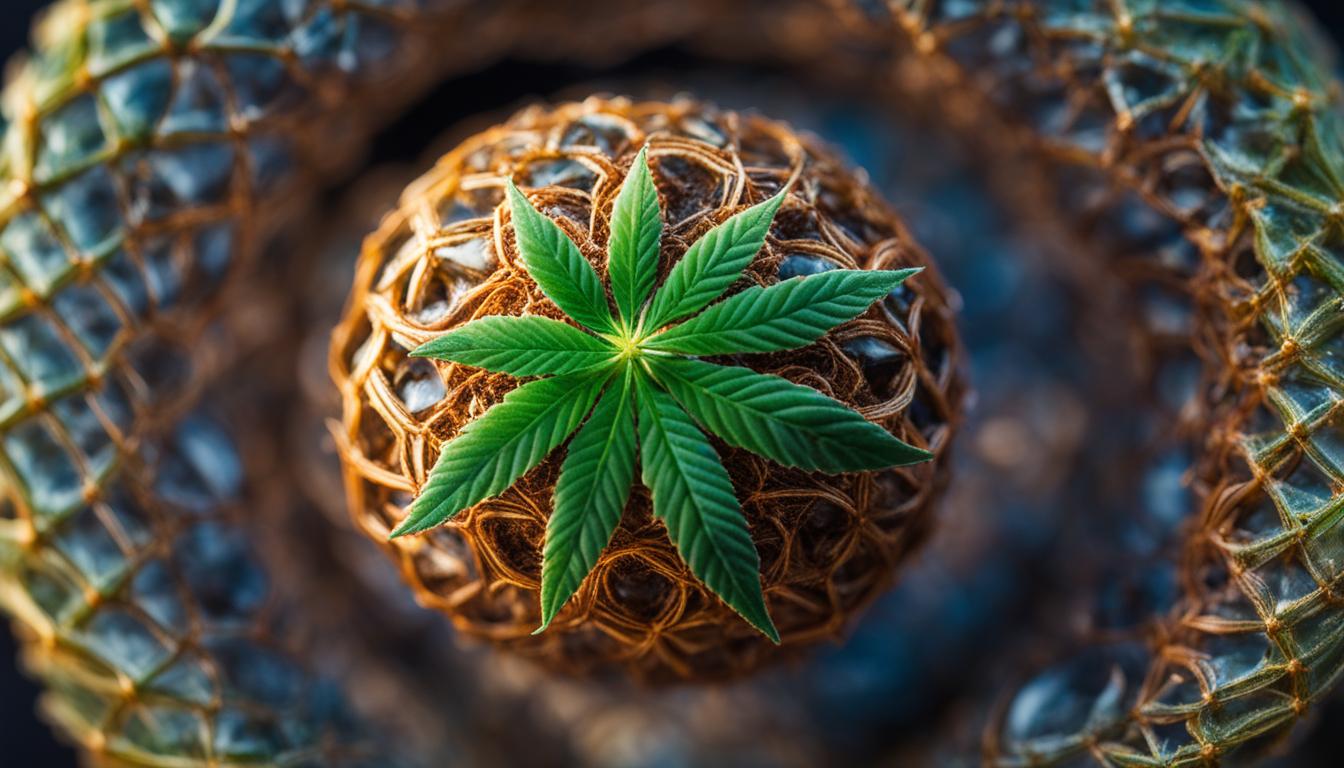Uncategorized
Cannabis Graine Guide: Cultivation & Care Tips
Welcome to our comprehensive guide on cannabis graine, also known as marijuana seeds or cannabis seeds. Whether you’re a beginner or an experienced grower, this guide will provide you with valuable tips and insights to help you successfully cultivate cannabis. Understanding the cultivation process and providing proper care are key factors in unlocking the potential of your cannabis graine.
Key Takeaways:
- Learn about the different types of cannabis seeds available, such as feminized and autoflowering seeds.
- Choose a reputable cannabis seed bank to ensure high-quality seeds.
- Follow the proper germination methods for successful sprouting.
- Provide adequate light, water, and nutrients for healthy plant growth.
- Maintain the optimal pH level to prevent nutrient lockout.
Buying Cannabis Seeds: Tips and Considerations
When it comes to starting your cannabis cultivation journey, buying high-quality cannabis seeds is the first step towards success. But with so many options available, how do you choose the right seeds? Here are some tips and considerations to keep in mind:
- Choose a reputable cannabis seed bank: To ensure you’re getting the best cannabis seeds, it’s important to buy from a trusted source. Look for a reputable cannabis seed bank with positive reviews and recommendations from other growers. This will give you peace of mind knowing that you’re purchasing seeds from a reliable source.
- Consider your preferred strain or type: Each cannabis strain offers unique characteristics and effects. Whether you’re looking for high THC content, specific flavors, or medicinal benefits, consider the strain that aligns with your preferences. Additionally, think about whether you want feminized cannabis seeds or autoflowering cannabis seeds, which have different growing characteristics.
To give you a head start, here are some top cannabis seed banks known for their quality seeds:
- I Love Growing Marijuana
- Seedsman
- Crop King Seeds
Comparison of Top Cannabis Seed Banks
| Seed Bank | Seed Quality | Strain Variety | Customer Reviews |
|---|---|---|---|
| I Love Growing Marijuana | 🌟🌟🌟🌟🌟 | 🌟🌟🌟🌟 | 🌟🌟🌟🌟🌟 |
| Seedsman | 🌟🌟🌟🌟 | 🌟🌟🌟🌟🌟 | 🌟🌟🌟 |
| Crop King Seeds | 🌟🌟🌟🌟🌟 | 🌟🌟🌟🌟 | 🌟🌟🌟🌟 |
Remember, researching and selecting the right cannabis seeds from a reputable seed bank paves the way for a successful cultivation journey. Stay informed, consider your preferences, and choose the seeds that best align with your goals.
Germination: Starting Your Cannabis Seeds
Germinating Cannabis Graine is the foundational step in cultivating healthy cannabis plants. Begin by selecting high-quality seeds from reputable sources to ensure viability. The germination process involves gently placing the Cannabis Graine between moist paper towels, allowing them to sprout roots. Keep the environment warm and humid, mimicking spring conditions, to encourage germination. Regularly check the moisture levels to prevent drying out or over-saturation, ensuring optimal conditions for Cannabis Graine to flourish.
Patience is key during Cannabis Graine germination. Typically, seeds will sprout within a few days to a week, although some may take longer. Once the Cannabis Graine has developed a healthy taproot, it’s ready for planting. Carefully transfer the germinated seeds into a growing medium, such as soil or a hydroponic setup, ensuring the taproot is facing downwards. Provide adequate light, water, and nutrients to support the seedling’s growth. Proper care during this critical stage sets the foundation for robust cannabis plants.
Successful germination of Cannabis Graine sets the stage for a thriving cannabis garden. As the seedlings emerge, monitor environmental conditions closely to prevent stress or nutrient deficiencies. Maintain a consistent light cycle and temperature to promote healthy growth. As the plants mature, continue to provide optimal care to maximize yields and potency. By mastering the art of germination, cannabis enthusiasts can unlock the full potential of their Cannabis Graine and cultivate premium-quality buds for personal use or medicinal purposes.
Germination Tips:
Germination Tips are essential for maximizing the potential of cannabis graines. Firstly, ensure a conducive environment by providing warmth and moisture. Placing cannabis graines between damp paper towels within a sealed container creates a humid atmosphere ideal for germination. Additionally, maintaining a consistent temperature between 70-90°F encourages faster sprouting. Secondly, patience is key during the germination process. Cannabis graines may take anywhere from 24 hours to a week to sprout, so resist the urge to disturb them. Keeping the environment stable and avoiding excessive handling promotes successful germination. Lastly, transplant seedlings carefully once they develop roots. Handle cannabis graines delicately to avoid damaging emerging roots, ensuring a smooth transition to their growing medium.
For successful germination, cannabis graines demand attention to detail. Start by selecting high-quality graines from reputable sources to ensure viability. Properly storing cannabis graines in a cool, dark place maintains their freshness and viability for future use. When preparing cannabis graines for germination, soak them in distilled water for 12-24 hours to jumpstart the process. Plant them in a well-draining medium, ensuring they’re covered with a thin layer of soil for protection. Regularly monitor moisture levels to prevent over or under watering, as both can hinder germination. By following these steps, cannabis graines can sprout healthily and robustly.
To optimize germination success, timing plays a crucial role in planting cannabis graines. Begin germination indoors a few weeks before the last frost date for your region. This allows seedlings to establish themselves before transitioning outdoors. Light is also a vital factor during germination. Provide cannabis graines with gentle, indirect light to stimulate growth without overwhelming them. As seedlings emerge, gradually introduce them to stronger light sources to promote healthy development. By meticulously timing the germination process and providing adequate lighting, cannabis graines can flourish into vigorous plants ready for their vegetative stage.
Cannabis Graine Care: Light, Water, and Nutrients
Cannabis Graine care revolves around three crucial elements: light, water, and nutrients. Proper light exposure is essential for the growth of Cannabis Graine plants. Providing the right intensity and duration of light ensures optimal photosynthesis, leading to healthy growth and robust yields. Whether indoor or outdoor cultivation, monitoring light conditions is paramount to nurturing thriving Cannabis Graine crops.
Water is another critical factor in Cannabis Graine care. Maintaining adequate hydration levels is vital throughout the plant’s lifecycle. Proper watering practices prevent issues like dehydration or waterlogging, safeguarding the health and productivity of Cannabis Graine plants. Consistent monitoring of soil moisture and providing water as needed ensures optimal growth and development.
Nutrient management plays a pivotal role in Cannabis Graine cultivation. Providing a balanced blend of essential nutrients is crucial for fostering vigorous growth and maximizing yields. Tailoring nutrient solutions to meet the specific needs of Cannabis Graine plants at different stages of growth is key to achieving optimal results. By adhering to proper nutrient schedules and practices, growers can unlock the full potential of their Cannabis Graine crops, producing high-quality yields consistently.
Lighting for Cannabis Cultivation
In the realm of cannabis cultivation, lighting plays a pivotal role in fostering optimal growth and maximizing yields. Selecting the right lighting system is crucial for nurturing healthy cannabis plants from Cannabis Graine to maturity. LED (Light Emitting Diode) lights have emerged as a popular choice among cultivators due to their energy efficiency and customizable spectrum, tailored to the specific needs of Cannabis Graine. These lights mimic the natural sunlight spectrum, promoting vigorous vegetative growth and robust flowering stages.
Cultivating cannabis from Cannabis Graine requires a nuanced understanding of lighting cycles. During the germination phase, gentle fluorescent lighting ensures seeds sprout uniformly, laying the foundation for healthy growth. As the plants mature, transitioning to high-intensity discharge (HID) lights such as metal halide (MH) or high-pressure sodium (HPS) provides the intense illumination necessary for bud development. Proper lighting management not only accelerates growth but also influences cannabinoid and terpene production, crucial for the desired potency and flavor profiles of Cannabis Graine.
The strategic placement of lights within the cultivation space significantly impacts plant development. By adjusting light intensity and positioning, cultivators can mitigate issues such as stretching and uneven growth, ensuring uniform canopy coverage and maximizing light absorption. Supplemental lighting techniques, such as side lighting and intercanopy lighting, further optimize light distribution, particularly in densely packed grow rooms. With meticulous attention to lighting conditions from Cannabis Graine to harvest, cultivators can unlock the full genetic potential of their cannabis strains, yielding bountiful, high-quality crops.
Watering Tips for Cannabis Plants
Ensuring proper hydration is crucial for cultivating healthy cannabis plants, and mastering watering techniques is paramount for optimal growth. When nurturing cannabis graine, timing is key. Watering should be done when the soil feels dry about an inch deep. Overwatering can lead to root rot, stunting growth and jeopardizing the plant’s health. By allowing the soil to partially dry out between watering sessions, you create an environment where the roots can breathe and absorb nutrients effectively, fostering robust development.
The method of watering cannabis graine plays a significant role in their overall health. Employing a gentle, steady stream of water helps prevent soil erosion and ensures even distribution to the roots. Avoid dousing the plant with excess water, as this can lead to nutrient leaching and waterlogging. Instead, aim to provide sufficient hydration without overwhelming the soil. Consistency is key; maintaining a regular watering schedule promotes stability in the plant’s environment, aiding in consistent growth and nutrient uptake.
Understanding the specific water needs of cannabis graine at different stages of growth is essential for successful cultivation. While young seedlings require more frequent, light watering to establish healthy root systems, mature plants may need less frequent but deeper watering to accommodate their increased size and nutrient demands. Monitoring the moisture levels in the soil and adjusting watering frequency accordingly ensures that cannabis graine receive the appropriate hydration throughout their lifecycle. By adhering to these watering tips, cultivators can nurture thriving cannabis plants with vigor and vitality.
Nutrients for Optimal Growth
Essential in the cultivation of cannabis graine. Providing the right balance of nutrients is crucial for maximizing yield and potency. Nitrogen, phosphorus, and potassium are key elements necessary for robust growth and flowering in cannabis graine. These nutrients aid in the development of strong roots, lush foliage, and potent flowers, ensuring the plant reaches its full genetic potential.
In the quest for optimal growth, cannabis graine requires a carefully curated nutrient regimen. Macronutrients such as nitrogen support vigorous vegetative growth, while phosphorus encourages strong root development and flower production. Potassium plays a vital role in overall plant health, helping to regulate water uptake and improve stress tolerance. By providing the right nutrients in the correct ratios, cultivators can nurture healthy cannabis graine plants that produce abundant, high-quality yields.
Cultivating cannabis graine to its fullest potential involves more than just soil and water; it requires a nuanced understanding of nutrient requirements. Customizing nutrient solutions tailored to each growth stage ensures that cannabis graine receives the essential elements needed for robust growth and development. From seedling to harvest, a well-balanced nutrient regimen promotes optimal health, resilience, and productivity in cannabis graine cultivation, ultimately leading to a bountiful and rewarding harvest.
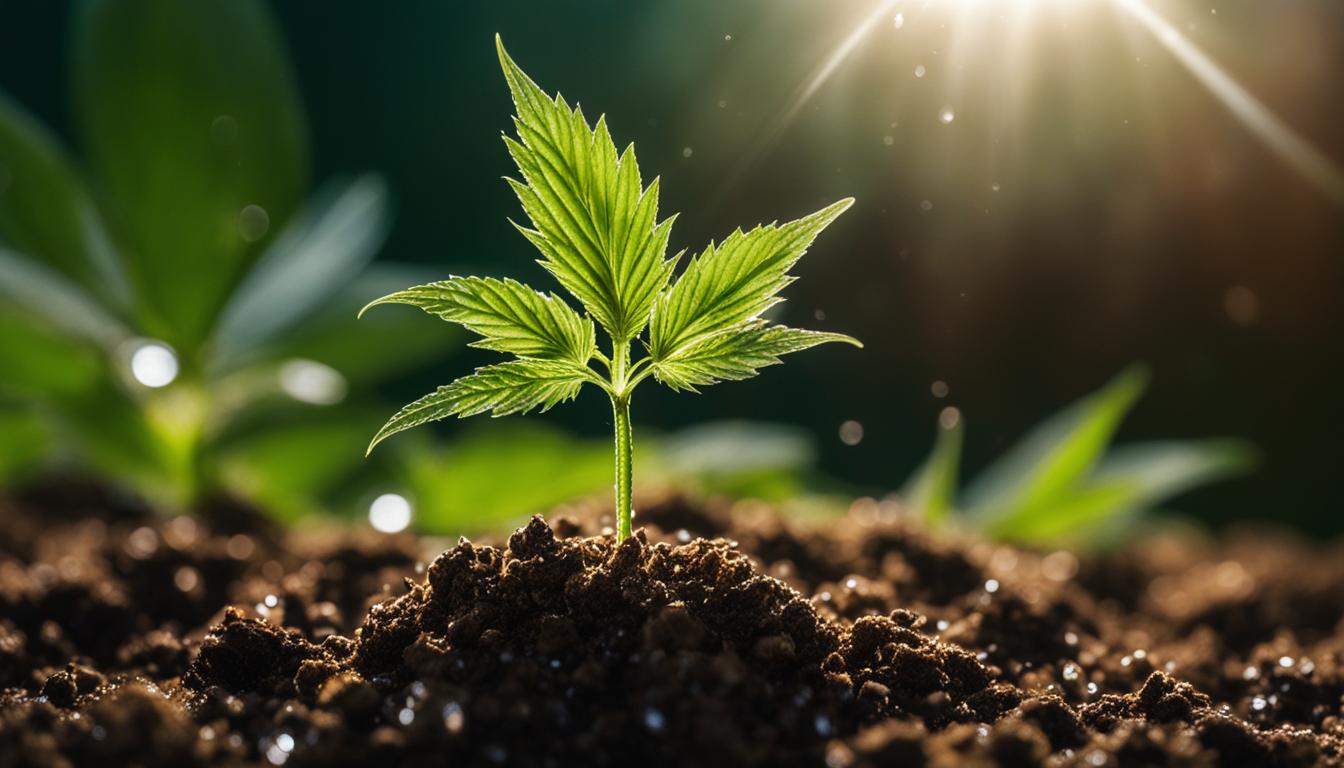
| Nutrient | Role | Sources |
|---|---|---|
| Nitrogen (N) | Promotes leafy growth and chlorophyll production | Compost, fish emulsion, blood meal |
| Phosphorus (P) | Stimulates root development, flower formation, and overall plant health | Bone meal, bat guano, rock phosphate |
| Potassium (K) | Aids in nutrient uptake, improves drought and disease resistance | Kelp meal, wood ash, granite dust |
| Micronutrients | Essential for various plant functions and overall health | Compost, seaweed extract, mineral amendments |
By providing your cannabis graine with adequate lighting, proper watering, and the right nutrients, you can create an optimal environment for their growth and maximize their potential. Remember to monitor your plants closely, adjust care as needed, and enjoy the rewarding journey of cannabis cultivation.
Understanding pH: The Key to Nutrient Uptake
pH levels play a crucial role in cannabis cultivation and nutrient uptake. The pH level of the growing medium affects the solubility and availability of essential nutrients for the plants.
When the pH deviates too much from the optimal range, a phenomenon known as nutrient lockout can occur. Nutrient lockout refers to the situation where certain nutrients become unavailable to the plants, even if they are present in the growing medium.
Understanding and managing pH levels is vital to prevent nutrient lockout and ensure proper nutrient uptake for healthy cannabis plants.
Importance of pH in Cannabis Cultivation
In cannabis cultivation, maintaining the right pH level is essential for the plants to absorb nutrients effectively. The optimal pH range for cannabis growth is typically between 5.5 and 6.5. When the pH deviates too much from this range, it can lead to nutrient deficiencies or toxicities.
At higher pH levels (alkaline), certain nutrients such as iron, manganese, and zinc become less available to the plants. This can cause deficiencies and negatively impact the plant’s overall health and growth. On the other hand, at lower pH levels (acidic), nutrients like phosphorus, potassium, and calcium may become less available, leading to imbalances and nutrient toxicities.
By maintaining the pH within the optimal range, growers can ensure that the cannabis plants have access to the necessary nutrients for healthy development and maximum yield.
Testing and Adjusting pH Levels
To manage pH levels effectively, it is crucial to regularly test the pH of the growing medium. This can be done using pH testing kits or electronic pH meters specifically designed for cannabis cultivation.
If the pH deviates from the desired range, adjustments can be made using pH-up or pH-down solutions. pH-up solutions increase the pH of the growing medium, while pH-down solutions lower it. These solutions should be used judiciously and following the manufacturer’s instructions to avoid drastic pH swings that can shock the plants.
Monitoring pH Levels Throughout the Growth Cycle
It is important to note that pH levels can change during different stages of the cannabis plant’s growth cycle.
During the vegetative stage, cannabis plants tend to prefer slightly higher pH levels. A pH range of 5.8 to 6.3 is commonly recommended during this stage. As the plants transition into the flowering stage, adjusting the pH towards the lower end of the optimal range, around 5.5 to 6.0, can help promote better nutrient uptake and bud development.
To ensure accurate adjustments, it is advisable to measure and adjust the pH of the nutrient solution or growing medium periodically throughout the growth cycle.
| Nutrient | Optimal pH Range |
|---|---|
| Nitrogen (N) | 6.0 – 7.0 |
| Phosphorus (P) | 6.0 – 7.0 |
| Potassium (K) | 6.0 – 7.0 |
| Calcium (Ca) | 6.0 – 7.0 |
| Magnesium (Mg) | 6.0 – 7.0 |
| Iron (Fe) | 5.5 – 6.5 |
Table: Optimal pH ranges for key nutrients in cannabis cultivation.
“Proper pH management is the key to unlocking the full nutrient potential of your cannabis plants. By maintaining the optimal pH range, you can ensure that your plants have access to the essential nutrients they need for healthy growth and abundant yields.” – Experienced Grower
Recognizing and Treating Nutrient Deficiencies
Nutrient deficiencies can impact cannabis plants, leading to poor growth and development. Understanding how to identify and address these deficiencies is crucial for successful cannabis cultivation.
Oftentimes, nutrient deficiencies in cannabis plants are caused by imbalances in pH levels, improper nutrient ratios, or inadequate nutrient availability. By keeping a close eye on your plants and being aware of the signs, you can take action to rectify the problem.
Signs of Nutrient Deficiencies
Recognizing the signs of nutrient deficiencies in cannabis plants is key to addressing the issue promptly. Keep an eye out for the following symptoms:
- Yellowing leaves
- Stunted growth
- Poor flower development
These symptoms can indicate specific nutrient deficiencies, such as a lack of nitrogen, phosphorus, potassium, or micronutrients like iron, magnesium, or zinc. By identifying the specific deficiency, you can target your efforts towards providing the necessary nutrients.
Treating Nutrient Deficiencies
Once you’ve identified a nutrient deficiency in your cannabis plants, you can take appropriate actions to address the issue:
- Adjust nutrient levels: Depending on the deficiency, you may need to adjust the nutrient levels in your growing medium. This can involve increasing the concentration of certain nutrients or balancing the nutrient ratios.
- Correct pH levels: Ensure that your pH levels are within the optimal range for nutrient uptake. Adjusting the pH of your growing medium can help prevent nutrient deficiencies and improve nutrient absorption.
- Apply foliar sprays: In some cases, foliar sprays can be beneficial for providing specific nutrients directly to the leaves of the plants. This can help address deficiencies more quickly and efficiently.
Remember to closely monitor your plants after taking corrective measures to ensure that the nutrient deficiencies are being resolved. Regular observation and appropriate adjustments will help your cannabis plants thrive.
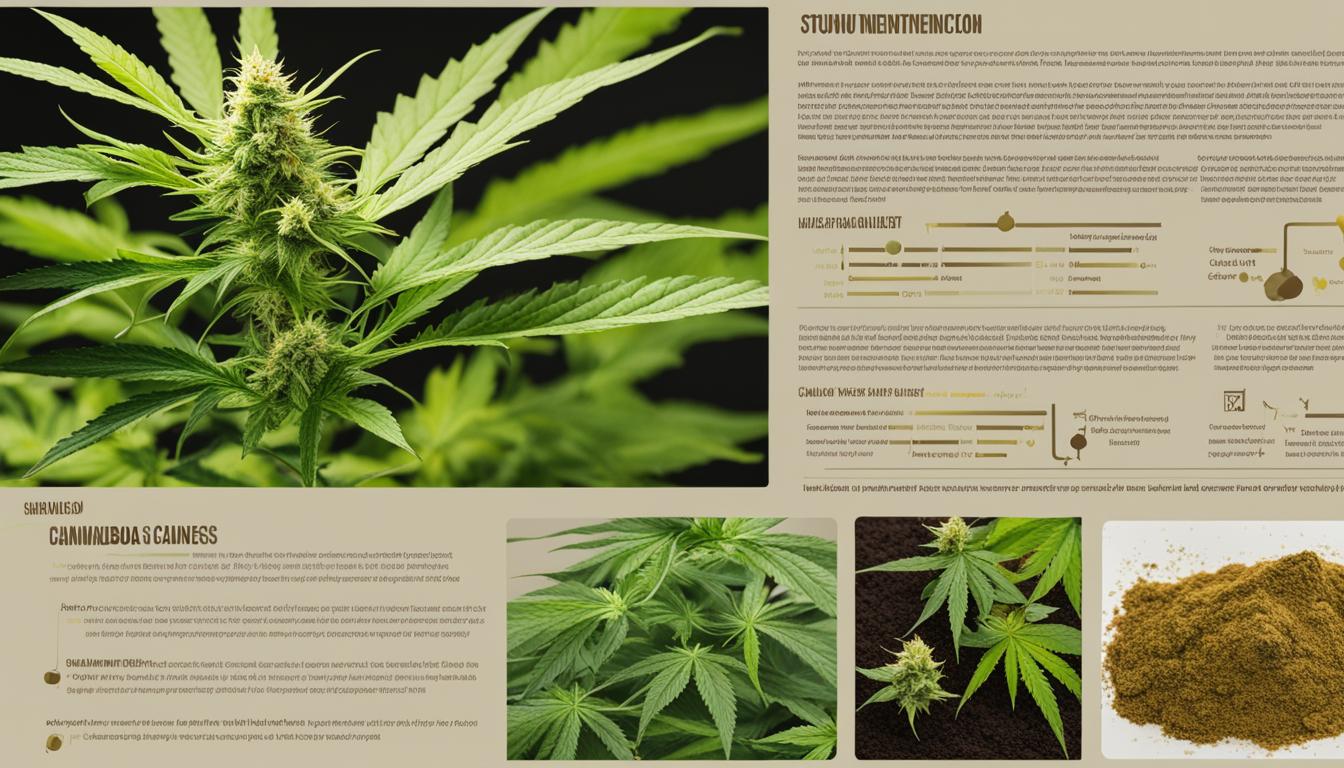
| Nutrient | Signs of Deficiency |
|---|---|
| Nitrogen | Yellowing leaves, stunted growth |
| Phosphorus | Purple or dark-colored leaves, weak stem |
| Potassium | Brown spots on leaves, weak branches |
| Iron | Yellowing between the veins, leaf tips turning brown |
| Magnesium | Yellowing leaves with green veins |
| Zinc | Small leaves, distorted growth |
Pest and Disease Prevention in Cannabis Cultivation
Cannabis plants are highly vulnerable to various pests and diseases, which can have a detrimental impact on their overall health and crop yield. Implementing effective preventive measures is crucial in order to maintain a healthy growing environment and minimize the risks of pest infestations and diseases.
One of the key practices for pest and disease prevention in cannabis cultivation is to ensure proper sanitation. Regularly clean your growing area and remove any debris or dead plant material that can harbor pests or pathogens. This helps to create an unfavorable environment for pests and reduces the chances of disease transmission.
Regular inspections are also essential to detect any signs of pest activity or disease symptoms at an early stage. Carefully examine your plants for any abnormal growth, discoloration, or presence of pests such as aphids, spider mites, or fungal infections. By spotting these issues early on, you can take prompt action to prevent further damage.
When it comes to pest control in cannabis cultivation, opting for organic methods is highly recommended. Chemical pesticides can have harmful effects on the plants, as well as the environment and human health. Instead, consider using natural alternatives like neem oil, insecticidal soaps, or beneficial insects such as ladybugs or predatory mites. These organic pest control methods are effective and safer for your plants.
Integrated Pest Management (IPM) is a holistic approach that combines various strategies to manage pests and diseases effectively. It involves a combination of preventive measures, biological control methods, cultural practices, and, if necessary, targeted use of pesticides. By integrating multiple strategies, you can tackle pest and disease issues in a sustainable and efficient manner.
Here is an example of an Integrated Pest Management strategy for cannabis cultivation:
| Pest/Disease | Prevention and Control |
|---|---|
| Aphids |
|
| Spider Mites |
|
| Powdery Mildew |
|
By prioritizing pest and disease prevention in your cannabis cultivation, you can ensure the overall well-being of your plants and maximize your crop yield. Remember to maintain proper sanitation practices, conduct regular inspections, use organic pest control methods, and implement Integrated Pest Management strategies. These proactive measures will help you cultivate healthy and thriving cannabis plants.
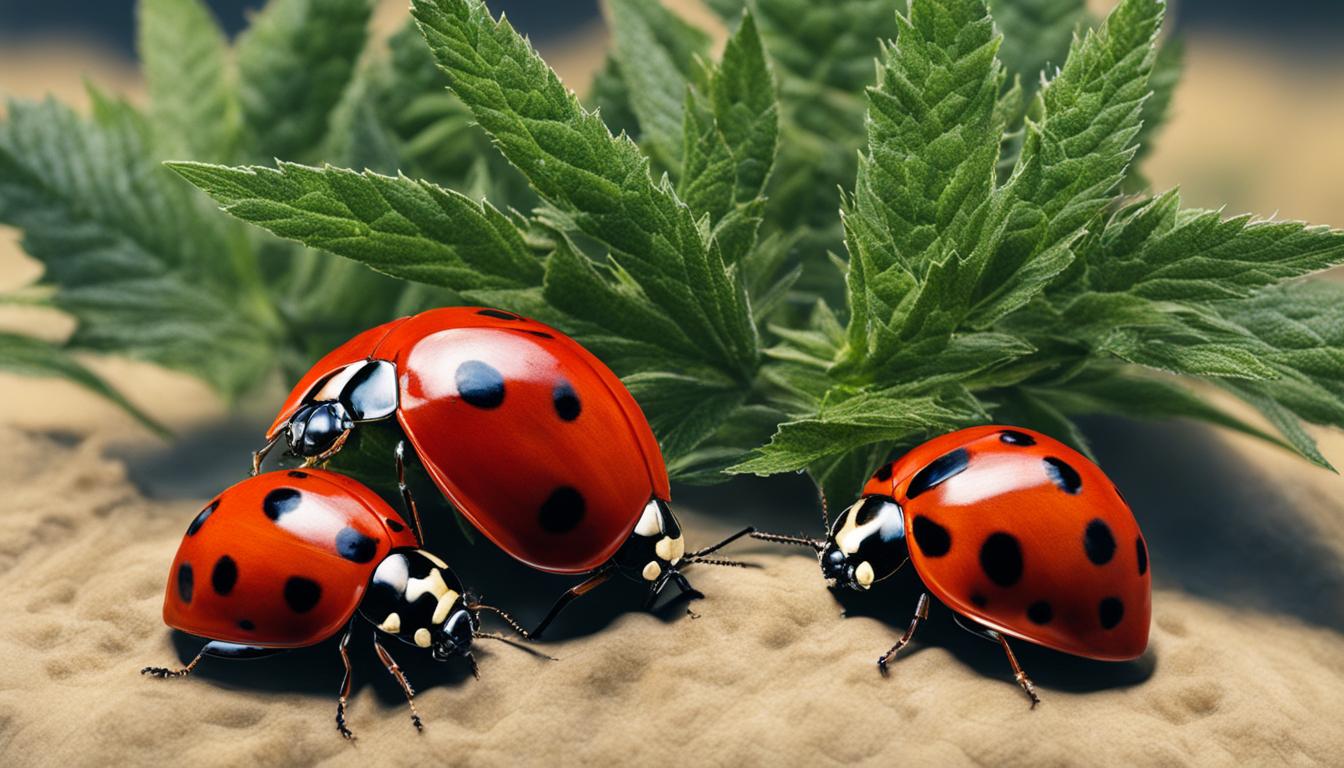
Harvesting and Curing Cannabis: Tips for Quality Results
Harvesting and curing are critical steps in the cannabis cultivation process that can significantly impact the quality of the final product. When it comes to harvesting, timing is crucial. It’s important to wait until the plants have reached their peak potency. One way to determine this is by observing the trichomes, which are tiny, crystal-like structures on the buds. When the trichomes change color from clear to milky or amber, it signifies that the cannabinoids are at their highest concentration, indicating that the plant is mature and ready for harvest.
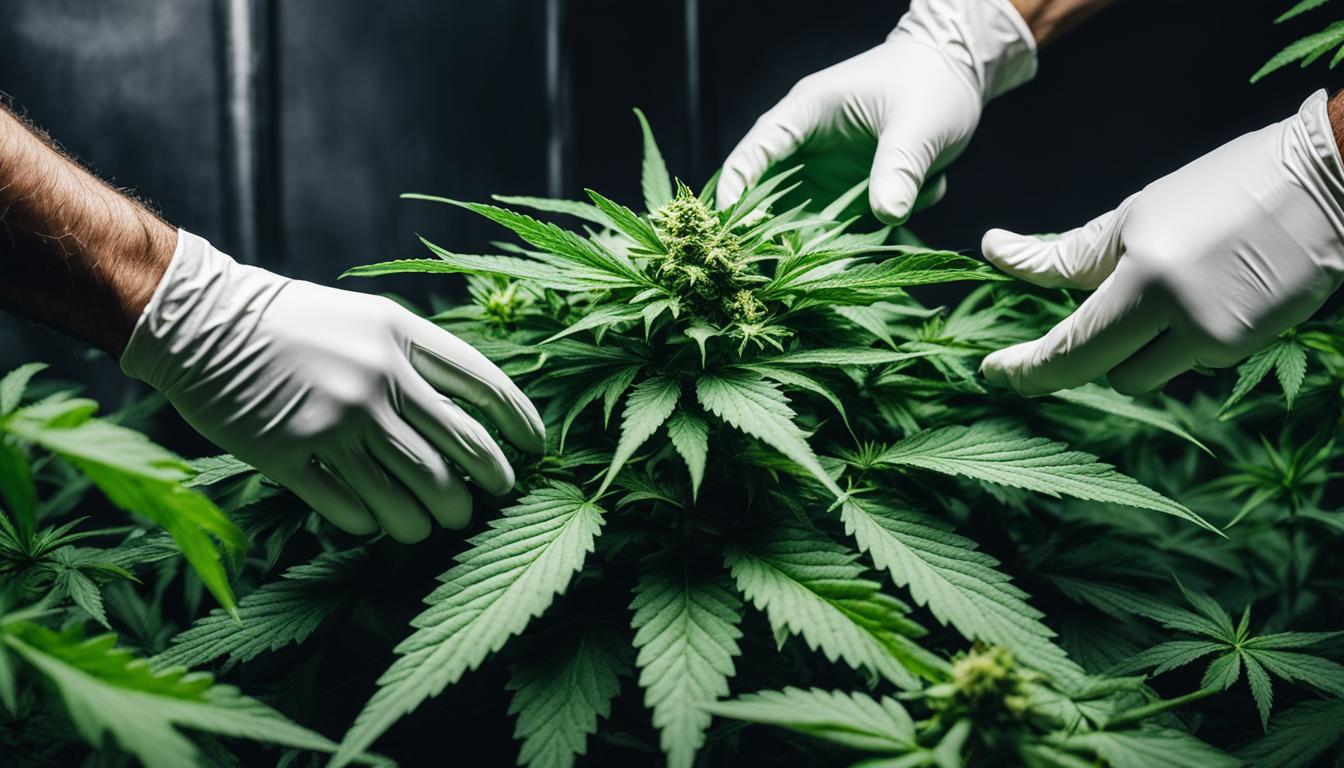
Once you’ve harvested your cannabis, the next step is curing. Curing is the process of drying the buds slowly in a controlled environment to remove excess moisture and enhance the flavors, aromas, and potency. Proper curing allows the buds to develop a smooth smoke and a more well-rounded experience for the consumer.
Here are some tips for a successful curing process:
- Hang the buds to dry: After harvesting, trim the excess leaves and hang the buds in a dark and well-ventilated room. Make sure to hang them upside down to allow for proper airflow.
- Maintain the ideal humidity: During the curing process, it’s crucial to maintain the proper humidity level of around 55-65%. This helps prevent mold growth while allowing the buds to dry slowly.
- Monitor the drying process: Keep a close eye on the buds to ensure they are drying evenly. You can check their progress by gently touching them to see if they feel crispy on the outside and slightly soft on the inside.
- Store the cured buds: Once the buds are sufficiently dry, transfer them to airtight containers, such as glass jars. This helps preserve the freshness and potency of the cannabis. Be sure to open the containers regularly to release any built-up moisture.
Curing cannabis can take anywhere from a few weeks to several months, depending on the desired flavor and potency. The longer the curing process, the smoother and more potent the final product will be. It’s worth the wait!
By following these tips for harvesting and curing, you can maximize the quality of your cannabis buds and enjoy a more satisfying and flavorful cannabis experience.
Conclusion
Cultivating cannabis from cannabis graine is a rewarding experience that requires knowledge, patience, and dedication. By following the tips and insights in this guide, you can enhance your cannabis cultivation skills and achieve quality results.
Starting with high-quality cannabis seeds is essential for a successful grow. Providing proper care, including adequate light, water, and nutrients, is crucial for the health and growth of your plants. Managing pH levels and preventing nutrient deficiencies will ensure optimal nutrient uptake and prevent any setbacks in your cultivation journey.
Additionally, implementing pest and disease prevention measures will help safeguard your plants and maximize their yield. Finally, when the time comes for harvesting and curing, paying attention to the plant’s maturity and properly drying and storing the buds will result in a final product that is flavorful, aromatic, and potent.
With these practices in place, you’ll be well on your way to achieving success in your grow cannabis endeavors. So, roll up your sleeves and get ready to enjoy the fruits of your labor as you embark on the exciting journey of cannabis cultivation.
FAQ
What are cannabis graine?
Cannabis graine, also known as marijuana seeds or cannabis seeds, are the seeds of the cannabis plant. They are used to grow cannabis plants for personal use or cultivation purposes.
Where can I buy cannabis seeds?
You can buy cannabis seeds from reputable cannabis seed banks, either online or in person. It is important to choose a trusted source that offers high-quality seeds. Take into consideration reviews and recommendations from other growers to ensure the reliability of the seed bank.
What are the best cannabis seeds to buy?
The best cannabis seeds to buy depend on your personal preferences and needs. There are various options available, including different strains and types of seeds. Feminized cannabis seeds are popular for their high yield and potency, while autoflowering cannabis seeds offer the advantage of faster and more convenient growth.
How do I germinate cannabis seeds?
There are different methods to germinate cannabis seeds. One common method is the paper towel method, where you place the seeds between moist paper towels until they sprout. Another method is planting the seeds directly in a grow medium. Each method requires keeping the seeds warm and moist, and it may take a few days to a week for the seeds to sprout.
What care do cannabis seeds need?
Proper care for cannabis seeds includes providing adequate light, water, and nutrients. Indoor growers can use grow lights, while outdoor growers rely on sunlight. Water your plants regularly, but avoid overwatering or underwatering. Finding the right balance is important. Additionally, ensure your plants receive the necessary nutrients by using organic fertilizers or nutrient-rich soil.
Why is pH important in cannabis cultivation?
pH levels play a crucial role in cannabis cultivation as they affect the availability and uptake of nutrients. Deviations from the optimal pH range can lead to nutrient lockout, where certain nutrients become unavailable to the plants, even if they are present in the growing medium. Managing pH levels is vital to prevent nutrient deficiencies and ensure healthy cannabis plants.
How do I recognize and treat nutrient deficiencies in cannabis plants?
Nutrient deficiencies in cannabis plants can manifest through yellowing leaves, stunted growth, or poor flower development. By identifying the specific nutrient deficiencies, growers can take appropriate actions such as adjusting nutrient levels, correcting pH levels, or applying foliar sprays with specific nutrients to address the issue.
How can I prevent pests and diseases in cannabis cultivation?
Preventive measures are crucial to minimize the risks of pest infestations and diseases in cannabis cultivation. This includes practicing proper sanitation, conducting regular inspections, using organic pest control methods, and implementing integrated pest management strategies. Prioritizing pest and disease prevention helps maintain a healthy growing environment and maximizes crop yield.
How do I harvest and cure cannabis?
Harvest your cannabis plants at the right time when they have reached their peak potency, which can be determined by observing the trichomes. After harvesting, proper curing is essential to preserve the flavor, aroma, and potency of the cannabis buds. This involves drying the buds slowly in a controlled environment and storing them in airtight containers.

